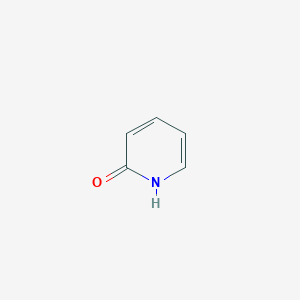| General Information of MET (ID: META00875) |
| Name |
2-Hydroxypyridine
|
| Synonyms |
Click to Show/Hide Synonyms of This Metabolite
1-Hydroxy-2-pyridine; 1H-Pyridin-2-one; 2(1H)-Pyridinone; 2(1H)-Pyridone; 2-Hydroxypyridine; 2-Hydroxypyridine sodium salt; 2-Oxopyridine; 2-Pyridinol; 2-Pyridinol (acd/name 4.0); 2-Pyridinone; 2-Pyridol; 2-Pyridone; Pyridin-2-ol; Pyridone-2; alpha -Pyridone; alpha-Pyridone
|
| Source |
Endogenous;Endogenous
|
| Structure Type |
Hydropyridines (Click to Show/Hide the Complete Structure Type Hierarchy)
Organoheterocyclic compounds
Pyridines and derivatives
Hydropyridines
|
| PubChem CID |
|
| HMDB ID |
|
| Formula |
C5H5NO
|
| Structure |
<iframe style="width: 300px; height: 300px;" frameborder="0" src="https://embed.molview.org/v1/?mode=balls&cid=8871"></iframe>
|
 |
|
3D MOL
|
2D MOL
|
|
Click to Show/Hide the Molecular/Functional Data (External Links/Property/Function) of This Metabolite
|
| KEGG ID |
|
| ChEBI ID |
|
| ChemSpider ID |
|
| Physicochemical Properties |
Molecular Weight |
95.1 |
Topological Polar Surface Area |
29.1 |
| XlogP |
-0.6 |
Complexity |
135 |
| Heavy Atom Count |
7 |
Rotatable Bond Count |
N.A. |
| Hydrogen Bond Donor Count |
1 |
Hydrogen Bond Acceptor Count |
1 |
| Function |
This colourless crystalline solid is used in peptide synthesis. It is well known to form hydrogen bonded structures somewhat related to the base-pairing mechanism found in RNA and DNA. It is also a classic case of a molecule that exists as tautomers. Some publications only focus one of the two possible patterns, and neglect the influence of the other. For example, to calculation of the energy difference of the two tautomers in a non-polar solution will lead to a wrong result if a large quantity of the substance is on the side of the dimer in an equilibrium. The direct tautomerisation is not energetically favoured, but a dimerisation followed by a double proton transfer and dissociation of the dimer is a self catalytic path from one tautomer to the other. Protic solvents also mediate the proton transfer during the tautomerisation.
|
|
Regulatory Network
|
|
|
|
|
|
|
|
|
 click to show the details of this protein
click to show the details of this protein
 click to show the details of experiment for validating this pair
click to show the details of experiment for validating this pair

